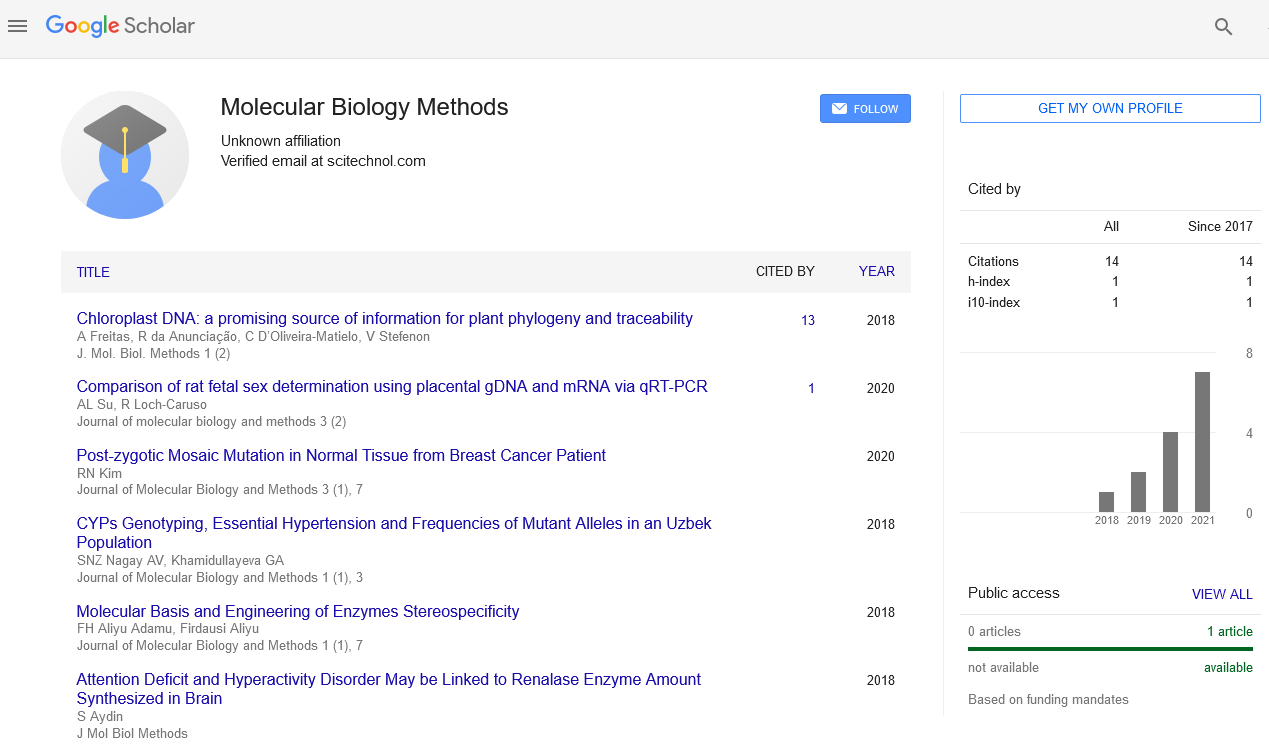Commentary, J Mol Biol Methods Vol: 7 Issue: 2
Macromolecule Blotting: Techniques, Applications, and Innovations
Yiping Yu*
1Department of Biological Engineering, Xinxiang University, Xinxiang, China
*Corresponding Author: Yiping Yu,
Department of Biological Engineering, Xinxiang
University, Xinxiang, China
E-mail: yu_yiping@edu.cn
Received date: 28 May, 2024, Manuscript No. JMBM-24-140276;
Editor assigned date: 31 May, 2024, PreQC No. JMBM-24-140276 (PQ);
Reviewed date: 14 June, 2024, QC No. JMBM-24-140276;
Revised date: 21 June, 2024, Manuscript No. JMBM-24-140276 (R);
Published date: 28 June, 2024, DOI: 10.4172/JMBM.1000160
Citation: Yu Y (2024) Macromolecule Blotting: Techniques, Applications, and Innovations. J Mol Biol Methods 7:2.
Description
Macromolecule blotting, a cornerstone technique in molecular biology and biochemistry, encompasses a range of methods designed to detect specific biomolecules such as nucleic acids, proteins, and lipids from complex mixtures. Originally developed in the 1970s, blotting techniques have evolved significantly, paralleling advancements in technology and understanding of biological molecules. This note explores the fundamental principles, variations, applications, and recent innovations in macromolecule blotting, highlighting its critical role in modern biological research.
Fundamental principles of blotting
At its core, macromolecule blotting involves the transfer of biomolecules from a gel matrix onto a membrane, where they can be subsequently probed with specific detection reagents. The three primary types of blotting techniques are Southern blotting, Northern blotting, and Western blotting, named after their applications to DNA, RNA, and proteins, respectively.
Southern blotting: Developed by Edwin Southern in 1975, Southern blotting enables the detection of specific DNA sequences within a complex mixture. The process begins with the separation of DNA fragments by gel electrophoresis, followed by transfer onto a membrane such as nitrocellulose or nylon. After transfer, the DNA on the membrane is hybridized with a labeled DNA probe complementary to the target sequence, allowing for visualization by autoradiography or chemiluminescence.
Northern blotting: A derivative of Southern blotting, Northern blotting is used to detect specific RNA sequences. RNA molecules are separated by gel electrophoresis based on size and transferred to a membrane. The membrane-bound RNA is then hybridized with a labeled RNA or DNA probe, complementary to the target RNA sequence, and visualized similarly to Southern blotting.
Western blotting: Western blotting is used to detect specific proteins within a complex sample. Proteins are separated by Polyacrylamide Gel Electrophoresis (PAGE), based on their molecular weight and charge. Following gel electrophoresis, proteins are transferred to a membrane (usually nitrocellulose or PVDF), where they are probed with specific antibodies that bind to the target protein. Detection can be achieved using enzyme-linked secondary antibodies or fluorescent probes, offering high sensitivity and quantification capabilities.
Applications of macromolecule blotting
Macromolecule blotting techniques find broad applications across various disciplines within biological research, clinical diagnostics, and biotechnology. Key applications include:
Gene expression analysis: Northern blotting remains valuable for studying gene expression patterns by detecting mRNA levels across different tissues or experimental conditions.
DNA analysis: Southern blotting is essential for mapping genes, identifying mutations, and analyzing genomic rearrangements, important in genetic research and diagnostics.
Protein detection and quantification: Western blotting is indispensable for detecting specific proteins, assessing protein expression levels, post-translational modifications, and protein-protein interactions.
Clinical diagnostics: Western blotting is widely used in clinical laboratories for detecting antibodies against specific pathogens (e.g., HIV) or autoantibodies associated with autoimmune diseases.
Forensic analysis: Southern blotting techniques have been historically used in forensic DNA analysis to match crime scene DNA with suspects.
Biotechnology applications: Blotting techniques are integral to recombinant DNA technology, including the characterization of cloned genes and the analysis of transgene expression.
Looking ahead, the field of macromolecule blotting continues to evolve with on-going advancements in detection sensitivity, automation, and multiplexing capabilities. Challenges such as sample complexity, background noise, and standardization of protocols remain areas of active research and development. Future innovations may focus on integrating blotting techniques with emerging technologies such as single-cell analysis and spatially resolved proteomics, further expanding their applications in both research and clinical settings.
Macromolecule blotting techniques have revolutionized the study of nucleic acids, proteins, and lipids, providing essential tools for molecular biologists, biochemists, and clinicians alike. From their humble beginnings to current innovations, these techniques continue to play a pivotal role in advancing our understanding of biological systems, diagnosing diseases, and developing new therapies.
 Spanish
Spanish  Chinese
Chinese  Russian
Russian  German
German  French
French  Japanese
Japanese  Portuguese
Portuguese  Hindi
Hindi 